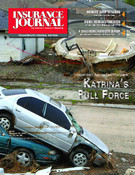Insurance regulators, on the heels of the National Catastrophe Insurance Summit in Burlingame, Calif., in November, are peddling the framework for a national catastrophe insurance program they say would protect U.S. taxpayers.
The details have not been ironed out, but the program’s ob-jectives are: To protect renters and homeowners by ensuring the affordability and availability of insurance against the financial consequence of natural catastrophic events; spread catastrophic risk broadly among individual insureds, insurers, reinsurers, states and the federal government in a public-private partnership; and reward mitigation of hazards.
In doing that, the commissioners propose eliminating the National Flood Insurance Pro-gram, developing state and regional catastrophe funds similar to Florida’s Hurricane Catastrophe Fund, creating a federal backstop for insurers, providing tax deferments for insurers to help build a fund earmarked for catastrophes and developing a national commission that would help to determine premiums based on actuarial data.
The proposal separated terrorism-related disasters from the national catastrophes, as well as focused on the habitational market of homeowners and renters, not commercial properties.
The plan is not designed to bailout insurers, but to help consumers in the event of a major natural catastrophe, the commissioners emphasized.
Economists and risk modeling companies AIR Worldwide Corp., EQECAT Inc. and RMS said losses from Katrina-estimated at $125 billion-would be dwarfed by costs to recover from major catastrophes such as a major earthquake in the Midwest on the New Madrid Fault, a category 3 hurricane that strikes the Northeast, or a nuclear attack at a port in Long Beach, Calif., that could create an estimated $2 trillion in exposures.
Although the summit was planned before Hurricanes Ka-trina and Rita made landfall, “you only need to look at the Gulf States to see the current [catastrophe insurance] system doesn’t work, California Insurance Com-missioner John Garamendi added. “We get a disaster, Air Force One swoops in, money, or deficit falls out the back. That’s not a good way to do it.”
The commissioners’ alternative would help to collect premiums before a disaster-not open the treasury after one occurs.
A layered approach
The plan proposes layered coverage, placing responsibility for funding natural disaster coverage on consumers first, then insurers, state and regional governments, and then the federal
government.
At the consumer/community level, strict building codes would be imposed and measures would be introduced to discourage consumers from residing in risky areas and help mitigate damage.
Private insurers then would be required to make catastrophic coverage available for all natural disasters, including flood, but not manmade terrorism losses. The premiums would be based on actuarially sound project loss costs, including costs of reinsurance. And catastrophe reserves would accumulate on a tax-deferred basis to help create an emergency fund that would be available when a disaster strikes.
At the state and regional level, a fund similar to Florida’s Hurricane Catastrophe Fund would provide coverage. This layer of coverage would begin after the first layer of catastrophic losses is reached, like reinsurance. A pool of smaller states could form a group fund if their size doesn’t warrant funds of their own.
Then, the federal government would be the last layer of protection. Coverage would begin after the state and regional layers of coverage have been reached. Federal funds would not come from the treasury, but instead would operate like a private reinsurance facility that would be managed by a national commission. The fund would be earmarked for catastrophe purposes only.
“The effort is not to develop a corporate shield, create a government bailout or a mechanism to give insurance companies bigger profits,” said Illinois Insurance Director Kevin McRaith. Instead, the national plan hopes to spread the liability for disaster recovery, with premiums reflecting the risk level homeowners face.
There was widespread agreement among the summit’s 140 attendees-insurance regulators from 16 states, insurance industry representatives, risk modeling firms, insurers and a handful of lawmakers-that a major catastrophe is inevitable and the nation needs a better system to help communities rebuild after a
disaster.
“There’s been an excellent overview of the problem and we’re about to come out with a potential solution and action plan. I’m finding very little disagreement-surprisingly so,” said James Woods, a representative from the National Association of Surplus Lines Offices Ltd. and attorney with LeBouef, Lam, Greene & MacRae, as he headed into a working group during the summit.
Yet it appeared that when summit attendees were separated into smaller groups, there was some debate about at what level the different governments would get involved, and whether the fund should be pre or post funded, among other concerns.
“In the small groups it was difficult to come to a consensus,” Woods said after the working groups concluded.
Topics Catastrophe Carriers Reinsurance Hurricane
Was this article valuable?
Here are more articles you may enjoy.


 10 Highest Class-Action Settlements in 2025 Eclipsed $70B Total: Duane Morris
10 Highest Class-Action Settlements in 2025 Eclipsed $70B Total: Duane Morris  Billionaire NFL Owner Suing Over Billboards Near His LA Stadium
Billionaire NFL Owner Suing Over Billboards Near His LA Stadium  Florida Insurance Agency VP Sentenced to 3 Years in Massive ACA Fraud Scheme
Florida Insurance Agency VP Sentenced to 3 Years in Massive ACA Fraud Scheme  MAPFRE Accuses AAA of Violating Long-Time Exclusive Marketing Agreement
MAPFRE Accuses AAA of Violating Long-Time Exclusive Marketing Agreement 


